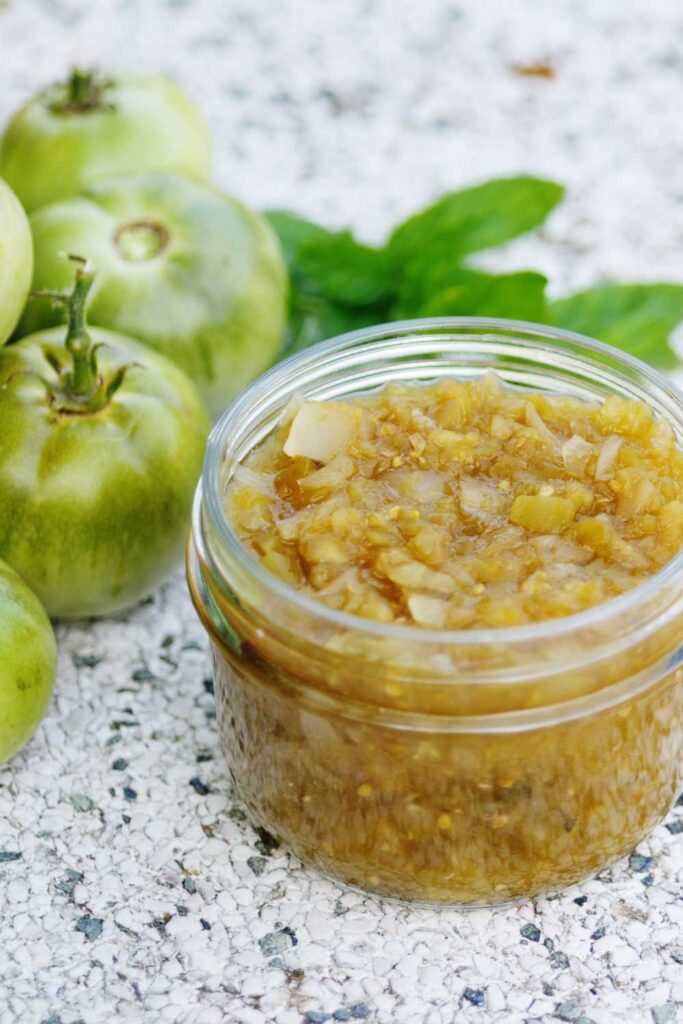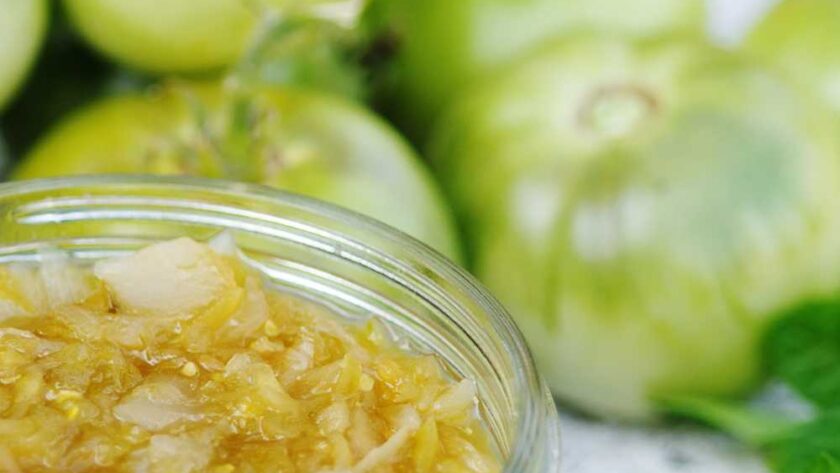I remember the first time I made green tomato chutney — it was the tail-end of summer, and my tomato plants were still loaded with stubborn green globes that refused to ripen. I’d been watching them like a hawk, whispering encouragement, even threatening them (don’t judge), but they weren’t having it. So instead of wasting the lot, I turned to the kind of recipe that makes you feel like you’re bottling up the last whispers of sunshine — James Martin’s green tomato chutney.
It’s got that sweet-sour backbone with just a whisper of heat, the kind of thing you want with cheddar and crusty bread, or slathered next to roast pork or cold sausages. Honestly, a spoon straight from the jar works too. And once you make your own chutney, those shop-bought jars taste like sugar water in comparison. This one? Chunky, vinegary, deep with flavour — and smells like every harvest kitchen I’ve ever loved.
Why You’ll Love It
- Tames unripened tomatoes into something glorious instead of letting them rot on the vine.
- Massively versatile. Goes on a sandwich, with cheese, in a ploughman’s — even with curry.
- Keeps for months. You’re basically making jars of edible treasure.
- The house smells incredible while it simmers — tangy, spicy, rich.
- A little goes a long way. One batch gives you enough to gift (if you can bear to).
- It’s oddly therapeutic. Something about chopping onions and stirring a bubbling pot makes the world slow down.
Ingredients
- 1kg green tomatoes (about 6 cups) — chopped, skin on is fine
- 1kg red onions — peeled and roughly chopped
- 150g raisins (golden or regular)
- 3 garlic cloves — minced
- ¼ tsp cayenne pepper
- ¼ tsp ground black pepper
- 2 tsp sea salt
- 500g brown sugar (light or dark)
- 1 litre malt vinegar
How to Make It
Get chopping:
Roughly chop the tomatoes and onions, and mince the garlic. Don’t be too precious with size — this is rustic. Add it all to a large stainless-steel saucepan, including the raisins.
Bring on the simmer:
Pour in the vinegar, then add the sugar, salt, cayenne, and black pepper. Give it a big stir and bring the pot to a boil over medium heat.
Slow and steady wins the chutney:
Once it starts bubbling, reduce to a lively simmer and let it do its thing uncovered. Stir every so often — especially as it thickens — so it doesn’t catch on the bottom. It’ll take around 1.5 to 2 hours.
Watch for the magic moment:
You’ll know it’s done when the mixture is thick and dark, and your spoon leaves a clear trail across the bottom of the pan. It should still be spoonable but not soupy.
Sterilise your jars (very important):
Wash your jars and lids with hot soapy water, then place them in a warm oven (about 140°C/285°F) for 10 minutes. Keep them warm until you’re ready to fill.
Pot it up:
Spoon the hot chutney into the warm jars (a funnel helps), leaving a little headspace. Seal with sterilised lids and let them cool completely. You might hear a gentle pop as the jars seal — it’s satisfying.
Let it mature (if you can wait):
Try to leave it for at least 2 weeks before digging in. A month is even better — the flavours mellow and deepen like a good cheese.

Common Mistakes and How to Dodge Them
Why’s my chutney runny?
You probably didn’t simmer it long enough. Keep going until it’s jammy and thick — patience pays off here.
Too vinegary?
It mellows as it matures, but if it’s really overpowering, your heat might’ve been too high. Simmer gently next time.
The lid went black — help?
That’s likely metal reacting with the vinegar. Use plastic-coated lids or place a wax disc on top of the chutney before sealing.
It’s too sweet!
Next time, go for a lighter brown sugar, or use a bit less. Taste before the final simmer and adjust if needed.
Storage and Reheating
Fridge:
Once opened, keep a jar in the fridge and use within 2–3 months.
Pantry:
Properly sealed and sterilised jars will keep for up to a year in a cool, dark cupboard.
Freezer:
Not traditional, but you can freeze chutney if needed. Use freezer-safe containers, leave headspace, and thaw in the fridge before using.
To reheat:
Honestly? You rarely need to. Just bring it to room temp, or give it a brief zap in the microwave if you’re feeling fancy.
Frequently Asked Questions
Can I use red tomatoes instead?
Not ideal. Green tomatoes have more acidity and firmness — they hold up better in chutney and give it that tart edge.
Can I can this for long-term storage?
Absolutely. Water-bathing the jars for 10 minutes is a good insurance policy, especially if gifting or storing for ages.
Can I reduce the sugar?
You can, but it affects the shelf life and flavour. Try cutting back 100g and taste from there.
What else can I add to spice it up?
Try mustard seeds, cloves, or even a little ginger for warmth. Go wild — chutney is forgiving.
Nutrition Facts (Per Serving):
- Calories: 652.7
- Fat: 0.2g
- Carbs: 36g
- Sugar: 35g
- Fibre: 1.7g
- Protein: 2%
- Sodium: 1.3g
Try More James Martin Recipes:

James Martin Green Tomato Chutney
Description
A tangy-sweet, spicy chutney made from unripened tomatoes, onions, and warm spices — the perfect companion for cheese boards and roast dinners.
Ingredients
Instructions
- Chop tomatoes, onions, raisins, and garlic.
- Combine all ingredients in a large pan and bring to a boil.
- Simmer uncovered for 1.5–2 hours, stirring often.
- When thick and dark, spoon into warm sterilised jars.
- Seal and let cool. Store in a dark cupboard for at least 2 weeks before eating.
Notes
- Use ripe green tomatoes — underripe ones can be too hard and bitter.
- Stir regularly while cooking to avoid sticking or burning.
- Always sterilise jars properly for food safety.
- The chutney improves massively after a few weeks of rest — patience is key.

